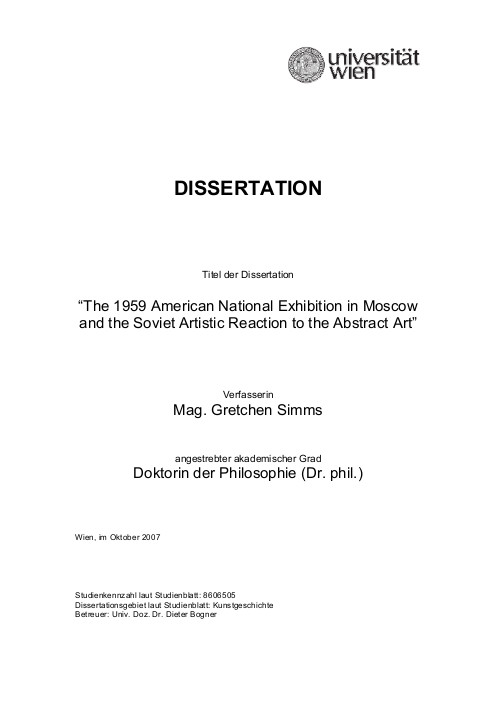Gretchen Simms: The 1959 American National Exhibition in Moscow and the Soviet Artistic Reaction to the Abstract Art (2007)
Filed under thesis | Tags: · abstract art, abstract expressionism, art history, cold war, cultural politics, politics, soviet union, united states

“The American National Exhibition was an exchange exhibition organised by the United States Information Agency (USIA) and took place at Sokolniki Grounds in Moscow in 1959. The overall director George V. Allen and the Association of Federated Artists (AFA) Vice President Lloyd Goodrich, who was also President of the Whitney Museum of American Art in New York, were responsible for the art section of the Exhibition. The art committee selected, intended to show the Soviet public the developments in modern American art since World War I.
The Soviet response to the Exhibition can only be fully appreciated by looking back at the developments within Russian and Soviet art as well as the political and social changes which the peoples in the Soviet Union experienced under Khrushchev. Through the analysis of the Soviet reception of the Exhibition, this dissertation shows how the Soviet public and especially the artworld in Moscow perceived specifically the American abstract art.
It reveals how the American abstract art displayed at the Exhibition facilitated the Soviet artists path in looking back at their Russian roots, looking within themselves and looking outside of their immediate boundaries in order to create new Soviet art.” (from the Abstract)
Art History, University of Vienna
Supervisor Dieter Bogner
191 pages
Ed Ruscha: Leave Any Information at the Signal: Writings, Interviews, Bits, Pages (2002)
Filed under book | Tags: · abstract expressionism, art, conceptual art, photography, pop art

“Ed Ruscha is among the most innovative artists of the last forty years. He is also one of the first Americans to introduce a critique of popular culture and an examination of language into the visual arts. Although he first made his reputation as a painter, Ruscha is also celebrated for his drawings (made both with conventional materials and with food, blood, gunpowder, and shellac), prints, films, photographs, and books. He is often associated with Los Angeles as a Pop and Conceptualist hub, but tends to regard such labels with a satirical, if not jaundiced, eye. Indeed, his work is characterized by the tensions between high and low, solemn and irreverent, and serious and nonsensical, and it draws on popular culture as well as Western art traditions.
Leave Any Information at the Signal not only documents the work of this influential artist as he rose to prominence but also contains his writings and commentaries on other artistic developments of the period. The book is divided into three parts, each of which is arranged chronologically. Part one contains statements, letters, and other writings. Part two consists of more than fifty interviews, some of which have never before been published or translated into English. Part three contains sketchbook pages, word groupings, and other notes that chart how Ruscha develops ideas and solves artistic problems. They are published here for the first time. The book also contains more than eighty illustrations, selected and arranged by the artist.”
Edited and with an Introduction by Alexandra Schwartz
Publisher MIT Press, 2002
October Books series
ISBN 0262182203, 9780262182201
473 pages
PDF (updated on 2022-11-13)
Comments (3)Michael Fried: Art and Objecthood: Essays and Reviews (1998)
Filed under book | Tags: · 1960s, 1970s, abstract expressionism, art criticism, art history, cubism, minimal art, painting, sculpture

“Much acclaimed and highly controversial, Michael Fried‘s art criticism defines the contours of late modernism in the visual arts. This volume contains twenty-seven pieces, including the influential introduction to the catalog for Three American Painters, the text of his book Morris Louis, and the renowned Art and Objecthood. Originally published between 1962 and 1977, they continue to generate debate today. These are uncompromising, exciting, and impassioned writings, aware of their transformative power during a time of intense controversy about the nature of modernism and the aims and essence of advanced painting and sculpture.
Ranging from brief reviews to extended essays, and including major critiques of Jackson Pollock, Morris Louis, Kenneth Noland, Jules Olitski, Frank Stella, and Anthony Caro, these writings establish a set of basic terms for understanding key issues in high modernism: the viability of Clement Greenberg’s account of the infralogic of modernism, the status of figuration after Pollock, the centrality of the problem of shape, the nature of pictorial and sculptural abstraction, and the relationship between work and beholder. In a number of essays Fried contrasts the modernist enterprise with minimalist or literalist art, and, taking a position that remains provocative to this day, he argues that minimalism is essentially a genre of theater, hence artistically self-defeating.
For this volume Fried has also provided an extensive introductory essay in which he discusses how he became an art critic, clarifies his intentions in his art criticism, and draws crucial distinctions between his art criticism and the art history he went on to write. The result is a book that is simply indispensable for anyone concerned with modernist painting and sculpture and the task of art criticism in our time.”
Publisher University of Chicago Press, 1998
Art History series
ISBN 0226263193, 9780226263199
333 pages
PDF (10 MB, updated on 2019-6-9)
Comment (0)
